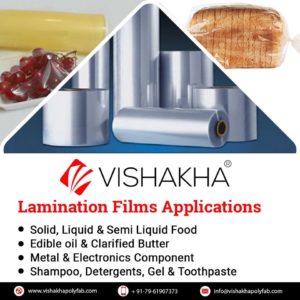The packaging industry has been revolutionized by flexible packaging systems. It entails the use of a flexible warping material to pack products. This is then sealed to prevent moisture, gas, water, biological and contaminants as well as physical damage to the materials.
Their utilization in the food industry alone is expected to reach $ 99600 million by 2018. This method is widely used in Europe, China, North America, India and Africa. Polythene has dominated this industry with a utilization of 32%. The future of this industry lies in the use of lamination films.

Types of Lamination Films and Adhesives
Laminates are manufacture by bonding two or more layers of polymeric materials. An adhesive is used to bond the materials so as to achieve the desired properties. For example an ordinary polythene film is laminated with another film layer to form 2 layers that increase strength.
Adhesive Lamination
The process can be done as dry or wet lamination. The dry process uses three technologies, dry bond, hot melt seal and cold seal. The adhesives are applied, dried and then used to stick the second laminate by compression. The wet forming process uses liquid adhesives that are directly bonded to the laminate and they stick the two materials when drying.
Extruded Laminations
These have more aesthetic appeal as compared to adhesive laminations and use multiple polymer layers. The first process uses a hot resin which is melted, extruded into a film that is bonded to another film.
The second process entails co-extrusion where two or more materials are melted, extruded to form films that are then bonded. Co-extrusion is a fast, reliable and superior method that forms many layers within one step.
Advantages over other Films
Laminates have superior merits as compared of other films or aluminum. First, by using different materials layered in one laminate, the materials become stronger and resist wear. Secondly, by using special films; gas, moisture, chemical and bacteria barrier is created. This shield pharmaceuticals and food from damage. Thirdly, the outside laminate film is made of materials that are easily printed and this advertises the product. Fourthly, by careful selection of laminate film, it is possible to adjust the seal-ability of materials.
Food, medicine and can react with packaging materials. To prevent this, a suitable material is selected for the inner film while the outer films are made of high strength materials. Laminates are cheap and affordable packaging technology.
These laminates are transparent as opposed to aluminum. Customers can view the product even when packed. Different materials such as EVOH, polyurethanes, vinyl acetate, polyvinyl, polyesters can be combined to achieve desired property.
Use of Flexible Packaging to Maximize Packaging Performance
This material is suitable for high production and flexible packaging films industry since the laminates can be shaped easily to form the packing container. By using many layers through co extrusion, it is possible to achieve high strength and more effective packaging barrier.
Typical applications of lamination films
This packing method is dynamic, cost effective, durable, and aseptic. It is widely applied in packing food and beverages, cosmetics, pharmaceuticals, liquor, agrochemical as well as electrical and electronics items.
UV Treated Lamination Films
These films are innovatively cured using special ultraviolet light. The laminates achieve high strength, chemical and water resistant and are more durable.
